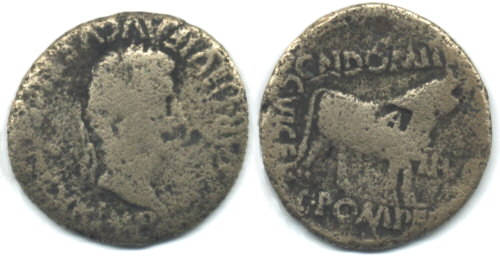identified after forty-two years!
AE27 brass, Augustus, from Lépida Celsa, Spain, minted 5 - 3 B.C.E.

identified after forty-two years!
AE27 brass, Augustus, from Lépida Celsa, Spain, minted 5 - 3 B.C.E.

|
diameter: 27mm avg., oval shape, 25mm-28mm dia. metal: brass weight: 8g. denomination: dupondius (?)
OBVERSE: Augustus, laureate portrait, facing right
REVERSE: bull emblazoned with letter A, facing right
mint: COLONIA VICTRIX IVLIA CELSA catalogue number: RPC_0278 is almost identical. |
|
I made a very satisfying discovery this morning! On browsing the Wildwinds
coin site, I thought I might try to look up something similar to a an old brass piece which I purchased some
forty-two years ago, when a child of eight! This coin was acquired at the Saratoga Coin Shop in Baltimore for the
enormous price of twenty-five cents... just about right for my budget at the time. I've come full circle in finances, too! This coin came to me, badly worn and defying identification, but it was nevertheless a pleasant early acquisition. I had been browsing a box of "junk" coins during one of my Saturday downtown visits. We'd all usually end up for lunch at the White Rice Inn in Baltimore's tiny Chinatown. As a historic collectible, it wasn't much, but it is one of the most cherished pieces in my collection because it's the one which started me in collecting Roman coins. Naturally, on a childhood visit to Washington's Smithsonian Institute, I didn't hesitate to bother the Curator of one of the nation's most extensive collections. "Can you tell me something about this coin, Sir?" I don't recall the gentleman's name, but he willingly indulged my request and pulled some tomes from the shelves in his office, examining the hopelessly worn coin while leafing through the texts. He came up with the possibility that this coin might be of First Century origin, from Spain or Southern Gaul. That wasn't too far off the mark, but at the time I was in ecstasy to have learned something new from the kindly scholar. By its size and metal, I guessed the coin to be a dupondius, then one-half a bronze sestertius in value, or one-eighth of a silver denarius. The dupondius was usually more brassy and squarish in shape, to distinguish it from the as, the denomination of half that value, i.e., one-sixteenth denarius. The as was generally a reddish bronze, whereas the dupondii and sestertii were made of brass, orichalcum, typically an alloy 80% copper and 20% zinc. Still, our "dupondius" might turn out to be the smaller coin, as indicated in the Wildwinds catalogue. Rome suffered inflation too. Initially the as was a huge cast coin of bronze, weighing a full Roman pound, libra= 335.9 grams. I displayed the two-faced image of Janus Bifrons. This monster coin was whittled down by inflation amid the Punic Wars. A denarius was initially the silver equivalent of ten of these, but around 100 B.C.E. it was revalued as sixteen as. On of my techniques was to hold worn coins under running water to make the lettering a bit more visibile. Some care obviously is required to assure that the drain is covered by a sieve or stopper! A lot of wedding rings are lost that way, I understand. Over the years, at widely spaced intervals, I gradually was able to transcribe nearly all the text from this little coin, greatly helped by seeing an inscription of Augustus from the cover of a Latin textbook. "Of course!" I noted, "All the emperors took the name, Augustus, but usually it appears abbreviated simply as AVG. Only one is the Augustus." Another piece of the puzzle fell into place, and I learned somewhere that Augustus (Octavian) did often favor the charging bull as a personal emblem. Perhaps, though, it was a mostly placid bull, considering his motto, FESTINA LENTE ... Make haste slowly! Among the issues remaining were that I could not read the number of consulship with certainty. COS XII seemed most plausible, indicating the twelfth term of Augustus as Consul, which would date the mintage of this coin as 4 B.C.E., give or take a year. That made it (at the time) the oldest coin in my growing collection, in two ways! The names on the reverse of the coin I thought to be the those of local officials responsible for the minting, perhaps Gnaeus Domitian, Gaius Vicellus, and Gaius Pompeiius. I realized only this morning that the assumption was but partially correct. Two names correspond to the duumvirs (II VIR) of the city, something like co-mayors. The third name, appearing as CVICEL, is actually C V I CEL, neither a number nor an official's name, but the name of the place of issue: Colonia Victrix Iulia Celsa, also known as Colonia Victrix Iulia Lepida. The modern place name is Velilla de Ebro, in Spain. What a curiosity! In finalizing my choice of Latin name, both IVLIA CELSA and IVLIA LEPIDA were near the top of my list! I settled at last with VOPISCA, suggested by a friend and historically attested among the Iulii. It means, essentially, "Survivor of Twins".
|
|
XI. KAL. OCT. MMDCCLV. A.V.C.
|